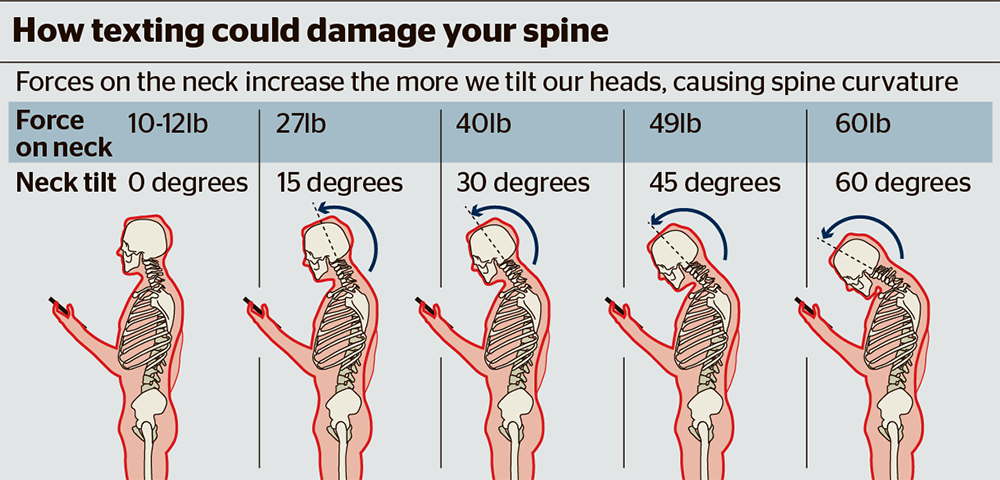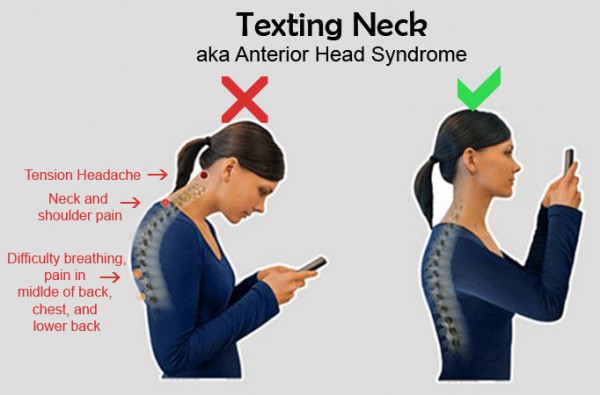In today’s hyper-connected world, our smartphones have become indispensable companions. From communication and work to entertainment and navigation, these devices seamlessly integrate into nearly every aspect of our lives. However, this constant digital tether comes at a cost, often manifesting as persistent aches and stiffness in the neck and shoulders – a phenomenon increasingly known as “text neck” or “smartphone shoulder.”
The human head is a surprisingly heavy organ, weighing between 10 to 12 pounds on average. When we hold our heads upright, the intricate network of muscles, ligaments, and bones in our neck is designed to support this weight with relative ease. The problem arises when we habitually tilt our heads forward and down to gaze at our phone screens.
Consider this: for every inch your head tilts forward, the effective weight on your cervical spine (neck) can increase dramatically. A mere 15-degree forward tilt can make your head feel like it weighs 27 pounds, while a 60-degree tilt, common during prolonged texting, can exert a staggering 60 pounds of force! This excessive strain forces the muscles at the back of your neck and upper shoulders to work overtime, constantly fighting gravity to keep your head from plummeting forward.

Over time, this sustained, unnatural posture leads to:
Muscle Imbalance: The deep neck flexors at the front of your neck, responsible for stability, become weak and elongated, while the muscles at the back of your neck and upper shoulders (like the trapezius and levator scapulae) become shortened, tight, and overused. This imbalance pulls your head forward and rounds your shoulders.
Increased Muscle Tension and Spasms: The constant strain leads to chronic tension, knotting, and even painful muscle spasms in the neck and upper back.
Joint Compression: The forward head posture can compress the facet joints in your cervical spine, leading to inflammation and degenerative changes over time.
Nerve Irritation: In some severe cases, this prolonged pressure can irritate or compress nerves, leading to symptoms like radiating pain, numbness, or tingling in the arms and hands.
Headaches: Tension headaches, often originating from the neck (cervicogenic headaches), are a common complaint among heavy smartphone users.
Beyond the Neck: The Impact on Shoulders
The shoulders are not immune to the effects of poor phone posture. When your head juts forward, your shoulders tend to round forward as well, often elevating towards your ears. This protracted and elevated position stresses the muscles connecting your neck to your shoulders (like the levator scapulae) and can lead to:
Shoulder Impingement: The rounding of the shoulders can narrow the space under the acromion, potentially pinching tendons or bursa in the shoulder joint during arm movements.
Rotator Cuff Strain: The altered mechanics of the shoulder girdle can put undue stress on the rotator cuff muscles, increasing the risk of strains or tears.
Reduced Shoulder Mobility: Chronic tightness in the upper trapezius and pectoralis muscles can limit the full range of motion in your shoulders.
Breaking Free from the Digital Ache: Solutions and Prevention
The good news is that “text neck” and “smartphone shoulder” are largely preventable and treatable. Here’s how to combat the digital ache:
Elevate Your Device: The simplest yet most effective solution. Hold your phone up to eye level as much as possible. This minimizes the degree of neck flexion. When sitting, consider using a stand or propping your arms on pillows to bring the screen closer to your gaze.
Take Frequent Breaks: Implement the “20-20-20 rule.” Every 20 minutes, take a 20-second break to look at something 20 feet away. Better yet, get up, move around, and gently stretch your neck and shoulders.
Practice Good Posture: Be mindful of your posture throughout the day, not just when using your phone. Imagine a string pulling the crown of your head towards the ceiling, aligning your ears over your shoulders and your shoulders over your hips.
Seeking Professional Help for Chronic Neck Pain: Don Kelly Physiotherapy and Acupuncture
While self-management strategies are crucial, persistent or chronic neck and shoulder pain warrant professional attention. Clinics like Don Kelly Physiotherapy and Dry Needling, with locations in Limerick and Charleville, specialize in addressing such issues, particularly chronic pain conditions.
Don Kelly Physiotherapy and Dry Needling offers a holistic approach that often combines the benefits of physiotherapy with the targeted relief of dry needling.
Physiotherapy: A core component of their treatment, physiotherapy aims to identify the root cause of your neck and shoulder pain. This involves a thorough assessment of your posture, movement patterns, muscle strength, and flexibility. Treatment often includes:
Manual Therapy: Hands-on techniques like joint mobilization, soft tissue release, and massage to reduce stiffness and improve movement.
Therapeutic Exercises: Tailored exercise programs to strengthen weakened deep neck flexors and core muscles, improve flexibility, and re-educate proper movement patterns. This is vital for correcting “text neck” posture.
Posture and Ergonomic Training: Guidance on optimal posture for daily activities, including smartphone and computer use, to prevent recurrence.
Pain Management Techniques: Utilizing modalities like heat, cold, ultrasound, or electrical stimulation to alleviate acute pain and inflammation.
Dry Needling: This modern therapeutic technique involves the insertion of a thin monofilament needle (similar to an acupuncture needle) into a myofascial trigger point – a hyperirritable spot in a taut band of skeletal muscle. For chronic neck and shoulder pain, dry needling is used to:
Release Muscle Tension: Directly target and “deactivate” stubborn trigger points, leading to immediate relaxation of tight muscles and reduced spasms.
Reduce Pain: By eliciting a “local twitch response” in the muscle, which can reset abnormal neurological activity and block pain signals.
Improve Range of Motion: Once muscle tension is released, the affected joints can move more freely, restoring mobility to the neck and shoulders.
Enhance Healing: The needling process can stimulate a local inflammatory response, increasing blood flow to the area and promoting the body’s natural healing processes.
Don Kelly Physiotherapy and Dry Needling emphasizes a personalized approach, understanding that chronic pain requires commitment and consistency. Their focus is on treating the whole person, looking beyond symptoms to find and address the underlying cause of dysfunction, helping patients reduce reliance on medication and regain control of their health. Testimonials often highlight their success in helping individuals find long-term relief from chronic neck and back pain.
While smartphones offer unparalleled convenience, it’s crucial to acknowledge their potential impact on our musculoskeletal health. By adopting conscious habits, prioritizing good posture, and incorporating regular movement and stretching into our daily lives, and seeking professional guidance from clinics like Don Kelly Physiotherapy and Dry Needling for persistent issues, we can continue to enjoy the benefits of digital connectivity without succumbing to the pervasive ache of “text neck” and “smartphone shoulder.” Your neck and shoulders will thank you for it.


